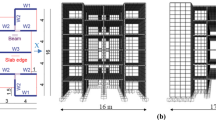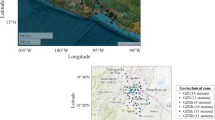Abstract
ESOPA-GUI, a MATLAB-based graphical user interface software, is presented in this study. The ESOPA-GUI estimates the seismic spectrum source parameters using Brune’s model (1970). The software uses two high-frequency decay models to represent the high-frequency decay of an event’s acceleration and displacement spectra: fmax-model and κ-model. The BODY-Q subprogram of ESOPA-GUI estimates and corrects the recorded time history corresponding to the loss of seismic energy by the wave propagation media. The software ESOPA-GUI has been applied to the data set of some earthquake of magnitude (MJ) 4.2 to 6.2, to estimate the spectral source parameters seismic moment (M0), moment magnitude (Mw), corner frequency (fc), stress drop (Δσ), source radius (r), fmax-model, and κ-model. The BODY-Q estimated the relationships Qβ = 26.68f1.01, Qβ = 31.56f0.96, and Qβ = 18.99f1.08 for different regions for Japan corresponding the data used, for the path correction. The solutions obtained using ESOPA are in good correlation with the solutions provided by popular agencies such as USGS and NIED which shows the reliability and stability of the software.


source parameters using ESOPA








source model

source model source model




source KIK-net)


Similar content being viewed by others
Data availability
The data used in the study to demonstrate the applicability and stability of ESOPA is downloaded from KIK-NET (NIED) Japan (https://www.kyoshin.bosai.go.jp/). Anyone can download data from the site.
References
Aki K (1967) Scaling law of seismic spectrum. J Geophys Res 72(4):1217–1231
Aki K (1969) Analysis of the seismic coda of local earthquakes as scattered waves. J Geophys Res 74(2):615–631
Aki K (1980) Scattering and attenuation of shear waves in the lithosphere. Journal of Geophysical Research: Solid Earth 85(B11):6496–6504
Anderson JG, Hough SE (1984) A model for the shape of the Fourier amplitude spectrum of acceleration at high frequencies. Bull Seismol Soc Am 74(5):1969–1993
Andrews DJ (1986) Objective determination of source parameters and similarity of earthquakes of different size. Earthquake Source Mechanics 37:259–267
Archuleta RJ, Cranswick E, Mueller C, Spudich P (1982) Source parameters of the 1980 Mammoth Lakes, California, earthquake sequence. Journal of Geophysical Research: Solid Earth 87(B6):4595–4607
Boore DM (1983) Stochastic simulation of high-frequency ground motions based on seismological models of the radiated spectra. Bull Seismol Soc Am 73(6A):1865–1894
Boore DM (1986) Short-period P-and S-wave radiation from large earthquakes: implications for spectral scaling relations. Bull Seismol Soc Am 76(1):43–64
Boore DM (2003) Simulation of ground motion using the stochastic method. Pure Appl Geophys 160(3–4):635–676
Brune JN (1970) Tectonic stress and the spectra of seismic shear waves from earthquakes. J Geophys Res 75(26):4997–5009
Dobrynina AA (2009) Source parameters of the earthquakes of the Baikal rift system. Izvestiya, Physics of the Solid Earth 45(12):1093
Douglas J, Gehl P, Bonilla LF, Gélis C (2010) A κ model for mainland France. Pure Appl Geophys 167(11):130–1315
Foster KM, Halldorsson B, Green RA, Chapman MC (2012) Calibration of the specific barrier model to the NGA dataset. Seismol Res Lett 83(3):566–574
Halldorsson B, Papageorgiou AS (2005) Calibration of the specific barrier model to earthquakes of different tectonic regions. Bull Seismol Soc Am 95(4):1276–1300
Hanks TC, Kanamori H (1979) A moment magnitude scale. Journal of Geophysical Research: Solid Earth 84(B5):2348–2350
Hanks TC, Boore DM (1984) Moment-magnitude relations in theory and practice. Journal of Geophysical Research: Solid Earth 89(B7):6229–6235
Havskov J, Ottemoller L (1999) SEISAN earthquake analysis software. Seismol Res Lett 70(5):532–534
Herrmann RB, Kijko A (1983) Modeling some empirical vertical component Lg relations. Bull Seismol Soc Am 73(1):157–171
Kanamori H, Given JW (1981) Use of long-period surface waves for rapid determination of earthquake-source parameters. Phys Earth Planet Inter 27(1):8–31
Khattri KM, Tyagi AK (1983) Seismicity patterns in the Himalayan plate boundary and identification of the areas of high seismic potential. Tectonophysics 96(3–4):281–297
Kumar A, Kumar A, Mittal H, Kumar A, Bhardwaj R (2012) Software to estimate earthquake spectral and source parameters. Int J Geoscie 3(5):1–8
Kumar R, Gupta SC, Kumar A, Mittal H (2015) Source parameters and f max in lower Siang region of Arunachal lesser Himalaya. Arab J Geosci 8(1):255–265
Lancieri M, Madariaga R, Bonilla F (2012) Spectral scaling of the aftershocks of the Tocopilla 2007 earthquake in northern Chile. Geophys J Int 189(1):469–480
Ma J, Dong L, Zhao G, Li X (2018) Discrimination of seismic sources in an underground mine using full waveform inversion. Int J Rock Mech Min Sci 106:213–222
Ma J, Dong L, Zhao G, Li X (2019) Focal mechanism of mining-induced seismicity in fault zones: a case study of yongshaba mine in China. Rock Mech Rock Eng 52(9):3341–3352
Ma’hood M, Hamzehloo H, Doloei GJ (2009) Attenuation of high frequency P and S waves in the crust of the East-Central Iran. Geophys J Int 179(3):1669–1678
Mandal P, Rastogi BK, Sarma CSP (1998) Source parameters of Koyna earthquakes, India. Bull Seismol Soc Am 88(3):833–842
Mayeda K, Walter WR (1996) Moment, energy, stress drop, and source spectra of western United States earthquakes from regional coda envelopes. Journal of Geophysical Research: Solid Earth 101(B5):11195–11208
Parolai S, Bormann P, Milkereit C (2001) Assessment of the natural frequency of the sedimentary cover in the Cologne area (Germany) using noise measurements. J Earthquake Eng 5(04):541–564
Sharma ML, Wason HR (1994) Occurrence of low stress drop earthquakes in the Garhwal Himalaya region. Phys Earth Planet Inter 85(3–4):265–272
Sokos EN, Zahradnik J (2008) ISOLA a Fortran code and a Matlab GUI to perform multiple-point source inversion of seismic data. Comput Geosci 34(8):967–977
Toro GR, Abrahamson NA, Schneider JF (1997) Model of strong ground motions from earthquakes in central and eastern North America: best estimates and uncertainties. Seismol Res Lett 68(1):41–57
Tucker BE, Brune JN (1977) Source mechanism and m b-M s analysis of aftershocks of the San Fernando earthquake. Geophys J Int 49(2):371–426
Yokoi T, Irikura K (1991) Meaning of source controlled fmax in empirical green’s function technique based on a T2-scaling law. Annuals of Disaster Prevention Research Institute, Kyoto University 34 B-1:177–189.
Vavryčuk V (2014) Iterative joint inversion for stress and fault orientations from focal mechanisms. Geophys J Int 199(1):69–77
Vavryčuk V, Adamová P, Doubravová J, Ren Y (2021) Mapping stress and fluids on faults by nonshear earthquakes. J Geophys Res Solid Earth 126(2):e2020JB021287
Yoshimoto K, Sato H, Ohtake M (1993) Frequency-dependent attenuation of P and S waves in the Kanto area, Japan, based on the coda-normalization method. Geophys J Int 114(1):165–174
Zeng Y, Anderson JG, Yu G (1994) A composite source model for computing realistic synthetic strong ground motions. Geophys Res Lett 21(8):725–728
Zobin VM, Havskov J (1995) Source spectral properties of small earthquakes in the northern North Sea. Tectonophysics 248(3–4):207–218
Acknowledgements
Authors are very thankful to USGS and KIK-net for providing free data as well as hypocentral parameters. The contribution of Indian Institute of technology is highly appreciated. We are very thankful to Abdullah M. Al-Amri, Editor-in-Chief, Arabian Journal of Geosciences, for cooperation and guidance. We are also very thankful to the reviewers of the manuscript for their valuable comments to enhance the quality of the manuscript.
Author information
Authors and Affiliations
Contributions
Dr. Rohtash Kumar: MATLAB code and manuscript writing.
Mr. Raghav Singh: Code and result assessment.
Dr. Subhash Chander Gupta: Overall supervision.
Mr. Amritansh Rai: Hotaka, Japan, earthquake analysis.
Mr. Prashant Singh: Takedamachi, Japan, earthquake analysis.
Mr. Aquib Ali: Namie, Japan, earthquake analysis.
Dr. Arjun Kumar: Body wave attenuation analysis.
Dr. Satya Prakash Maurya: Manuscript compilation and inversion of data.
Corresponding author
Ethics declarations
Conflict of interest
The authors declare no competing interests.
Additional information
Communicated by Longjun Dong.
Rights and permissions
About this article
Cite this article
Kumar, R., Singh, R., Gupta, S.C. et al. ESOPA: a GUI-based MATLAB platform for estimation of earthquake spectral source parameters, inelastic attenuation, high-frequency decay kappa, and fmax-model. Arab J Geosci 14, 2449 (2021). https://doi.org/10.1007/s12517-021-08739-z
Received:
Accepted:
Published:
DOI: https://doi.org/10.1007/s12517-021-08739-z




